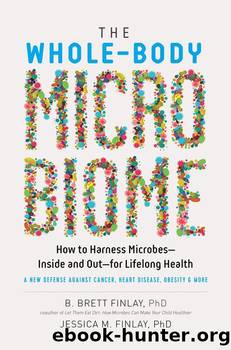The Whole-Body Microbiome by Brett Finlay & Jessica Finlay

Author:Brett Finlay & Jessica Finlay [Finlay, Brett & Finlay, Jessica]
Language: eng
Format: epub
ISBN: 9781615194810
Barnesnoble:
Publisher: Experiment, The
Published: 2019-01-01T00:00:00+00:00
This text file has been provided by The Experiment for purposes of review only. It may only be used by authorized recipients and may not be reproduced, copied, circulated, published, or posted online.
love buGs
155
Microbiome_1B.indd 155
9/12/18 10:14 AM
THE BIG FAT SURPRISE
There is a re-think underway regarding the role of saturated fat and CVD. Dr.
Ancel Keys, a powerful scientific figure in the 1950s to 1970s, initially championed the concept that high saturated fat leads to high cholesterol and heart disease. He persuasively advocated for the American Heart Association and
the broader scientific community to stress the need to decrease fat intake
and make it public enemy number-one. We all very much âtook it to heartâ:
Dietary fat intake in the US dropped by 11 percent since the 1970s, and grocery stores still stock many low-fat and non-fat foods.
But we had to eat something, preferably something that tastes good! So
instead we increased our carbohydrate consumptionâthis includes adding
sugarâby at least 25 percent. We now know that added sugar and refined carbohydrates also increase risk for CVD. Saturated fat is just one piece of the puzzle, and butter, meat, and cheese in moderation are part of a healthy diet. If you want the sordid details, check out The Big Fat Surprise by Nina Teicholz.
Here are the American Heart Associationâs current facts on fat:
⢠LOVE IT: Unsaturated fats lower rates of CVD. Healthy fats containing good HDL cholesterol, such as olive oil, beans and legumes, whole
grains, fatty fish, and nuts act like a vacuum for the arteries. They
remove bad LDL cholesterol and plaque buildup, and reduce risk of
heart disease.
⢠LIMIT IT: Saturated fats are no longer forbidden but should be consumed in moderation. They occur naturally in many foods, including
meatâe.g., fatty beef, lamb, pork, poultry with skinâand dairy prod-
ucts; e.g., cream, butter, cheese. It is recommended to aim for no
more than 5 to 6 percent of daily calories from saturated fats.
⢠LOSE IT: Artificial trans fat, hydrogenated oils, and tropical oils, such as palm kernel oil, increase risk of CVD and raise bad cholesterol
levels. Try to save commercially fried foods and baked goods for rare
This text file has occasions.
been provided by The Experiment for purposes of review only. It may only be used by authorized recipients and may not be reproduced, copied, circulated, published, or posted online.
156
THE WHOLE-BODY MICROBIOME
Microbiome_1B.indd 156
9/12/18 10:14 AM
Heart Chemistry, or the Science Behind
CVD
MYTH: red meat
Now letâs get to the âmeat of the matterâ
alone causes heart
regarding microbes and CVD. We know that
disease.
meat eaters, especially red meat consumers,
have a higher CVD risk than vegetarians. In
FACT: red meat does
studies, germ-freeâi.e., microbe-freeâanimals
not cause cvD by itself:
have a very low CVD risk, even if these ani-
itâs how our microbes
mals are fed diets that increase the risk of CVD
break down the red
in animals that arenât germ-free; i.e., have a
meat and create harmful
normal microbiota. Why is this? Meat and egg
by-products that lead to
yolks are rich in two structurally related com-
heart disease.
pounds: L-carnitine and choline, and these
compounds make up about 2 percent of the
Western diet. Through a series of reactions, the gut microbes convert
these compounds into a molecule waste by-product called trimethyl
amine (TMA).
Download
This site does not store any files on its server. We only index and link to content provided by other sites. Please contact the content providers to delete copyright contents if any and email us, we'll remove relevant links or contents immediately.
| Administration & Medicine Economics | Allied Health Professions |
| Basic Sciences | Dentistry |
| History | Medical Informatics |
| Medicine | Nursing |
| Pharmacology | Psychology |
| Research | Veterinary Medicine |
A History of the Human Brain by Bret Stetka(492)
The Spike by Mark Humphries;(463)
Basic Exercise Physiology by Moran S. Saghiv & Michael S. Sagiv(462)
The Plague Cycle by Charles Kenny(445)
The Whole-Body Microbiome by Brett Finlay & Jessica Finlay(420)
Virus Mania by Torsten Engelbrecht; Köhnlein Claus(397)
The Genetic Lottery by Kathryn Paige Harden(379)
Reviews of Physiology, Biochemistry and Pharmacology by Unknown(377)
Your Brain on Exercise by Gary L. Wenk(342)
Lymph & Longevity by Gerald Lemole(337)
Biophysics of Membrane Proteins by Unknown(325)
Soft-Wired: How the New Science of Brain Plasticity Can Change Your Life by Dr. Michael Merzenich Phd(294)
Fixing My Gaze by Susan R. Barry; Oliver Sacks(286)
Anatomy of the human body: Anatomy body part by Anik Ahmed(285)
Corona, False Alarm?: Facts and Figures by Karina Reiss && Sucharit Bhakdi(282)
Netter's Clinical Anatomy E-Book by John T. Hansen(280)
Structural Immunology by Unknown(255)
Essentials of Pathophysiology by Tommie L. Norris(244)
Brain Weaver, Volume 1 by Andrew Newberg(222)
